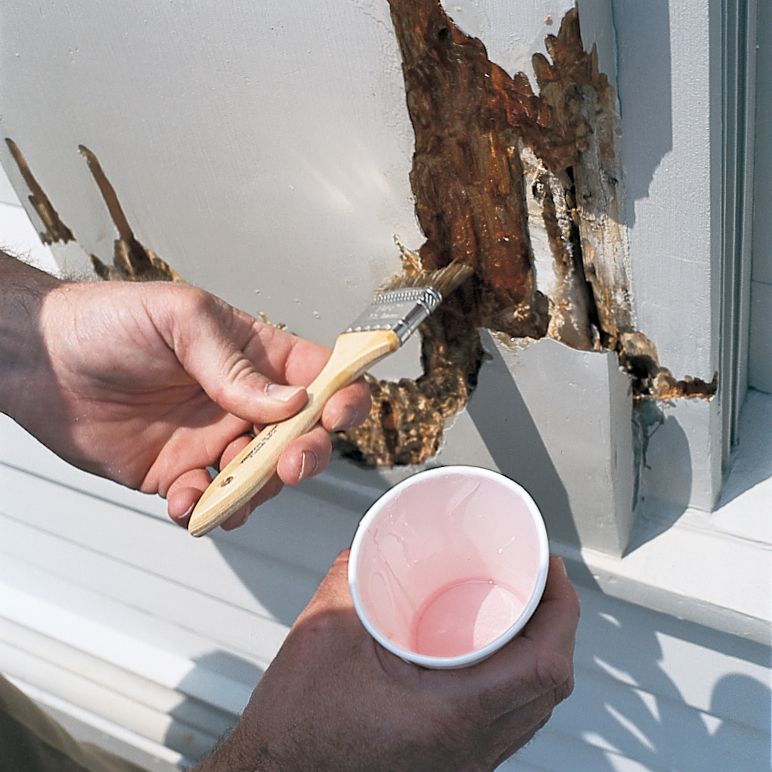Project details
Skill
Cost
Estimated Time
Rotted trim can be an eyesore and cause a number of problems, like attracting pests or harboring mold. Fortunately, repairing rotted trim with epoxy is affordable and effective. Our guide will walk you through how to identify rot, prepare the area, and use epoxy to restore your trim.
Why Wood Rot Happens
Wood rot is a common problem with exterior trim, especially in areas exposed to moisture. Before making repairs, take time to understand how and why your trim is degrading. If these problems persist, even if you repair your trim, it will only continue to mold and rot again.
Common Causes of Rot
Wood rot typically occurs when moisture levels in the wood remain high for extended periods. This creates an ideal environment for fungi to thrive, leading to decay. Here are some common causes:
- Poor drainage around windows and doors
- Improperly sealed joints or cracks
- Inadequate ventilation in crawl spaces or attics
- Sprinkler systems that consistently wet wooden surfaces
- Overflowing or broken gutter systems
Identifying Rotted Areas
Detecting rot early is key to preventing extensive damage. Look for these signs of wood rot:
- Soft or spongy wood when probed with a screwdriver
- Discoloration or darkening of the wood
- Cracked or peeling paint
- Visible fungal growth or a musty odor
- Wood that easily crumbles or breaks apart
Essential Tools and Materials for Repairing Rotted Trim
Here’s a quick overview of the essential tools and materials you’ll need to repair rotted wood trim.
Epoxy Products
Epoxy is the star of this show. You’ll need the following:
- Two-part epoxy resin and hardener
- Epoxy wood filler
- Epoxy primer
Additional Supplies
You’ll also need the following tools and safety gear:
- Protective gear (gloves, safety glasses, dust mask)
- Screwdriver or awl for probing
- Hammer and chisel for removing rotted wood
- Sandpaper (various grits)
- Paintbrushes and stirring sticks
- Plastic putty knife
- Wood preservative
- Paint that matches your trim
Preparing for the Rotten Trim Repair Process
Epoxy is generally one of the safer resins to work with—most brands produce very little gas at room temperature. However, it’s still a good idea to put safety first.
- Wear protective gloves, safety glasses, and a dust mask
- Work in a well-ventilated area
- Follow manufacturer instructions for handling epoxy products
- Keep children and pets away from the work area
Always read and follow the product’s instructions carefully before mixing and applying. If the instructions say to wear a mask, do so. If it says to wear a clear-air ventilator, do so.
Setting Up Your Work Area
It’s also best to create a clean, organized workspace:
- Lay down drop cloths to protect surrounding surfaces
- Ensure adequate lighting to see the repair area clearly
- Have a stable work surface for mixing epoxy
- Keep all tools and materials within easy reach
How to Repair Rotted Trim
Once you’ve gathered the necessary materials and prepared your workspace, you’re ready to begin.
Step 1: Remove Rot-Softened Wood
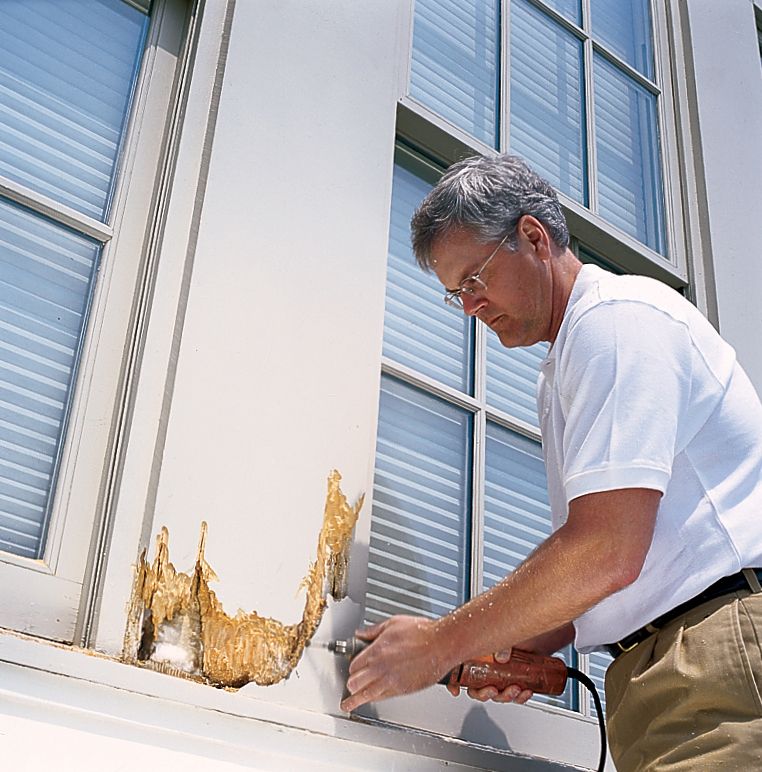
After clawing out the loose stuff with a hammer, remove all the rot-softened wood with a die grinder and core-box router bit. For an epoxy repair to be effective, the freshly exposed wood has to be sound and dry—less than 18% moisture content. Check it with a moisture meter before proceeding.
Step 2: Prime the Exposed Wood
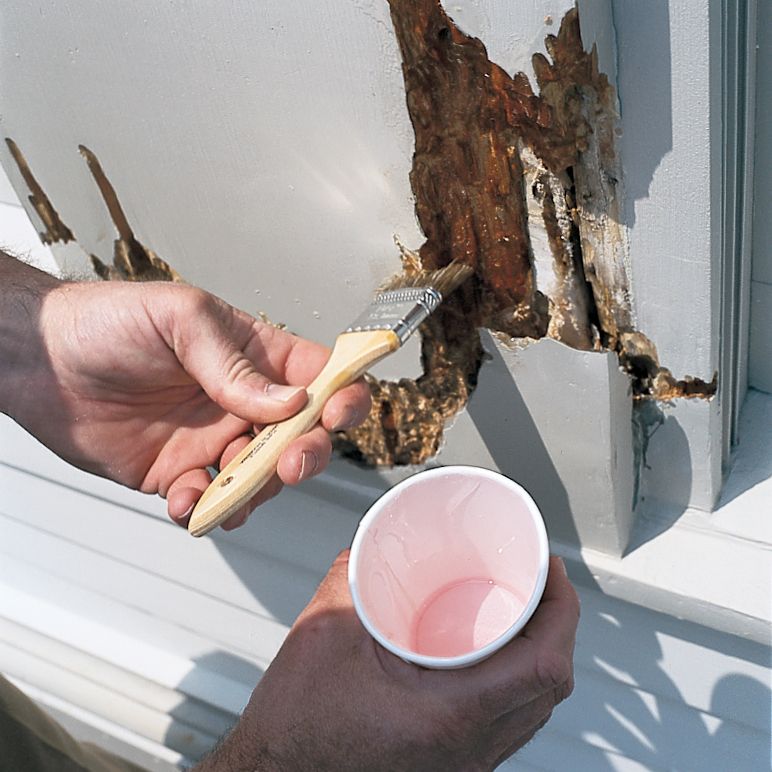
A two-part epoxy primer brushed on the exposed wood ensures that the final repair will bond to the surface. After waiting about 15 minutes for the thin liquid to penetrate, wipe off the excess with a paper towel. The surface is now ready for a coat of the two-part epoxy filler.
Step 3: Blend the Resin and Hardener
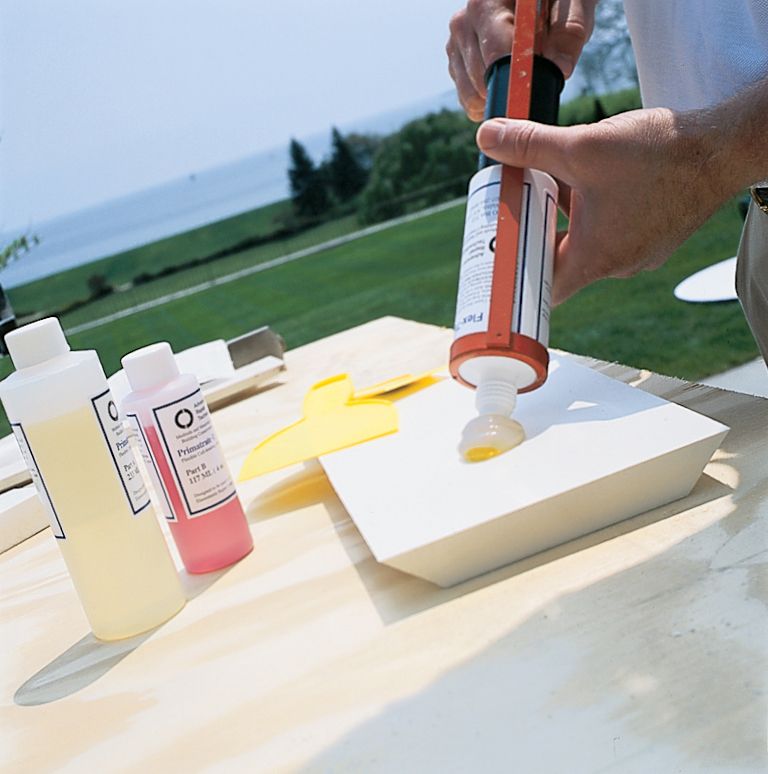
Epoxy for wood rot repair typically has two parts: resin and hardener. Follow the manufacturer’s instructions to blend them on a plastic board with a putty knife. Epoxy doesn’t stick to hard plastic surfaces, so the board and putty knife can be cleaned and reused.
Step 4: Sculpt the Epoxy
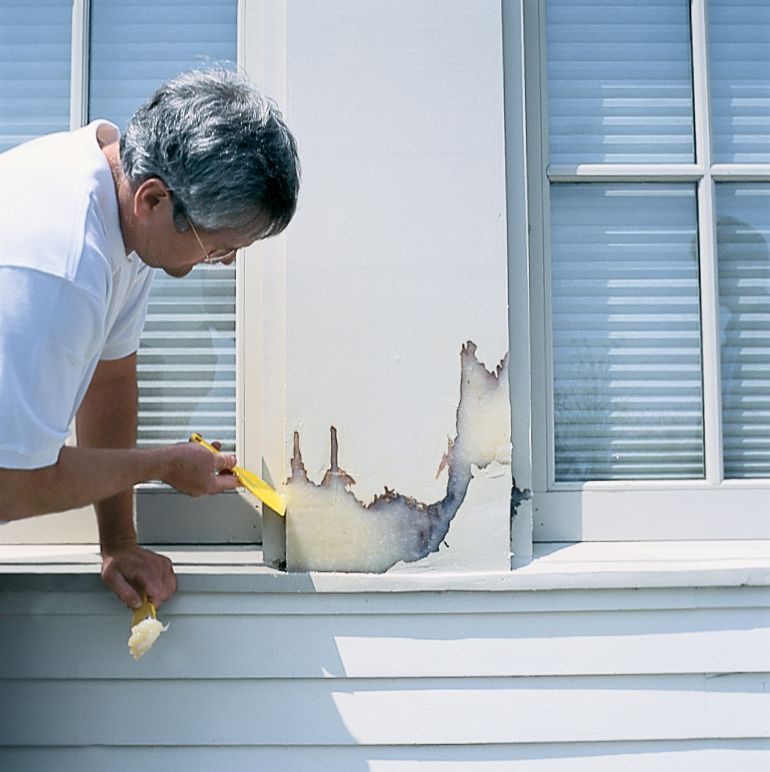
Using the same plastic putty knife, sculpt the viscous epoxy into shape. The mix remains workable for about 30–45 minutes (longer in cool weather and shorter when it’s hot).
Step 5: Paint the Epoxy

Epoxy breaks down in sunlight, so it needs to be painted. The next day, after the repair hardens, sand it smooth, first with 80-grit paper, then 100-grit, then 220-grit. An acrylic primer is next, followed by two coats of 100% acrylic paint.
Preventing Future Rot
Taking preventive measures can save you from future repairs and protect your home’s exterior. Consider implementing these maintenance practices:
- Inspect trim annually for signs of paint failure or moisture damage
- Clean gutters regularly to prevent overflow
- Ensure proper drainage away from your home’s foundation
- Trim vegetation away from the house to improve air circulation
- Ensure attics and crawl spaces are properly ventilated
- Use dehumidifiers in damp basements or crawl spaces
Alternatives To Epoxy Repairs
While epoxy is an excellent solution for many rot repairs, there are alternatives to consider.
Wood Filler Options
For smaller areas of damage, wood fillers can be effective:
- Cellulose wood fillers are easy to use and sand
- Two-part wood fillers offer durability similar to epoxy
- Exterior wood putty is suitable for filling small cracks and holes
These options are generally less expensive and easier to apply than epoxy but may not be as durable for larger repairs.
Complete Trim Replacement
In cases of extensive rot, replacing the entire piece of trim may be necessary. We recommend selecting trim made of rot-resistant materials like cedar, redwood, or composite products. Make sure the new trim is properly installed with flashing and caulking to prevent future water intrusion.
While more costly upfront, a replacement can provide a long-term solution for severely damaged trim.
When To Call a Professional
While many homeowners can successfully repair rotted trim with epoxy, some situations call for professional help, such as the following:
- Extensive rot that affects structural elements
- Repairs in hard-to-reach areas or at heights
- Lack of time or proper tools to complete the job safely
- Uncertainty about the extent of the damage or repair process
Professional carpenters or wood trim repair specialists can assess the damage and provide expert repairs, ensuring a long-lasting result.
